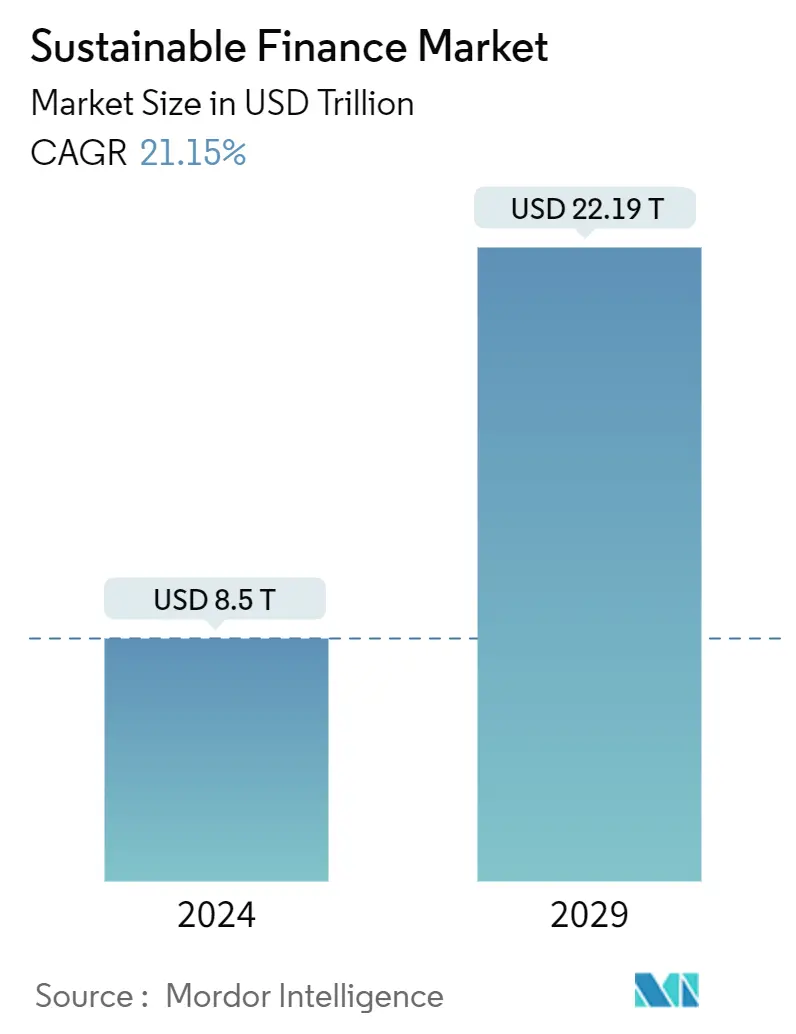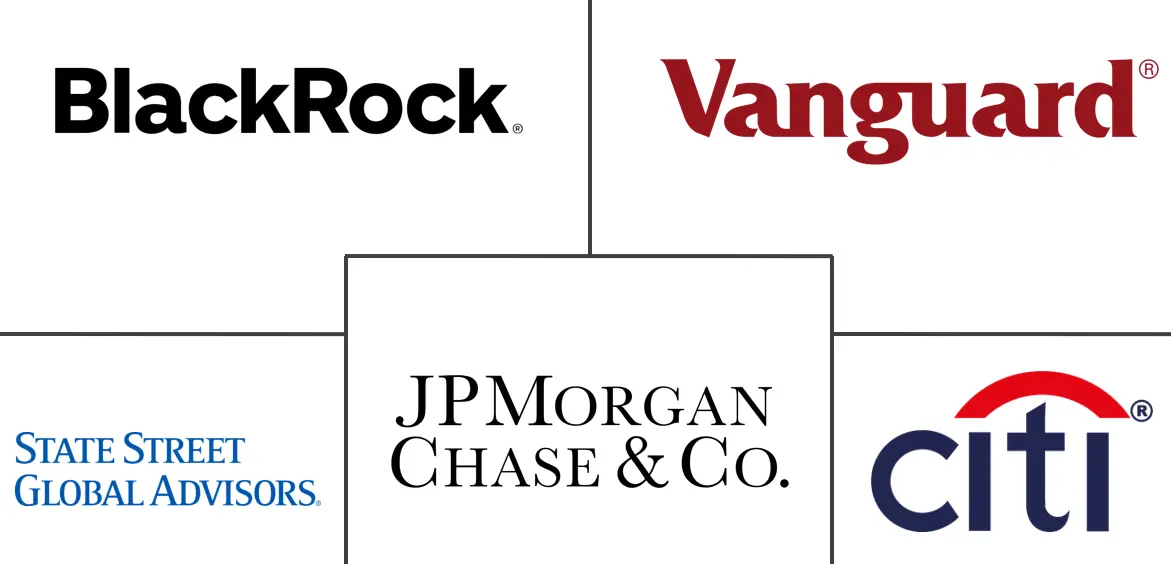Market Size of Sustainable Finance Industry

| Study Period | 2020-2029 |
| Market Size (2024) | USD 8.5 Trillion |
| Market Size (2029) | USD 22.19 Trillion |
| CAGR (2024 - 2029) | 21.15 % |
| Fastest Growing Market | North America |
| Largest Market | Asia Pacific |
| Market Concentration | Medium |
Major Players
*Disclaimer: Major Players sorted in no particular order |
Sustainable Finance Market Analysis
The Sustainable Finance Market size is estimated at USD 8.5 trillion in 2024, and is expected to reach USD 22.19 trillion by 2029, growing at a CAGR of 21.15% during the forecast period (2024-2029).
In recent years, sustainable financing has grown significantly. The demand has risen as more and more investors understand the effectiveness of sustainability and ESG elements in their investment plans. Many institutional investors have incorporated ESG criteria into their investment frameworks. They consider environmental and social aspects and corporate governance practices to assess investments' long-term sustainability and risk profile. Green bonds have become a popular instrument in sustainable finance. Socially Responsible Investing (SRI) focuses on investments aligning with ethical or social values. It involves screening companies involved in controversial activities and investing in businesses with a positive social impact. The availability and quality of ESG data have improved, enabling investors to make more informed decisions. Companies increasingly report on their ESG performance and disclose relevant information to meet investor demands.
Sustainable Finance Industry Segmentation
Sustainable finance compiles financial regulations, strategies, methodologies, and products designed to uphold environmental objectives. By funding its agents and pursuing a growth purpose, it makes it possible for the financial system to interact with the population and the economy. This report aims to provide a detailed analysis of the sustainable finance market. It focuses on insights into the many product and application types, market dynamics, and emerging trends in the segments and regional markets. It examines the competitive environment and the major players. The sustainable finance market is segmented by investment type, which includes equity, fixed income, and mixed allocation; by transaction type, including green bond, social bond, and mixed-sustainability bond; by industry, including utilities, transport and logistics, chemicals, food and beverage, and government; and by geography including North America, Europe, Asia-Pacific, South America, and the Middle East. The report offers the market size for the sustainable finance market in value terms in USD for all the abovementioned segments.
| By Investment Type | |
| Equity | |
| Fixed Income | |
| Mixed Allocation |
| By Transaction Type | |
| Green Bond | |
| Social Bond | |
| Mixed-sustainability Bond |
| By Industry | |
| Utilities | |
| Transport and Logistics | |
| Chemicals | |
| Food and Beverage | |
| Government |
| Geography | ||||||||
| ||||||||
| ||||||||
| ||||||||
| ||||||||
|
Sustainable Finance Market Size Summary
The sustainable finance market is experiencing significant growth, driven by increasing awareness and demand for investments that incorporate environmental, social, and governance (ESG) criteria. Investors are increasingly recognizing the importance of sustainability in their investment strategies, leading to a rise in the adoption of ESG elements. This shift has been supported by improved availability and quality of ESG data, enabling more informed decision-making. Green bonds have emerged as a key instrument within this market, providing a dedicated funding source for projects aimed at environmental benefits, such as renewable energy and sustainable infrastructure. These bonds offer investors a transparent and credible way to align their investments with their sustainability goals, contributing to the transition towards a more sustainable economy.
In North America, the demand for sustainable finance is particularly strong, with a growing interest in sustainable investments among investors. This has led to an increase in sustainable bond issuances, supported by favorable government policies and regulations. Investments in green infrastructure projects, such as climate resilience and renewable energy, have gained traction, with sustainable bonds serving as a crucial funding mechanism. The market is moderately consolidated, with major players like BlackRock, Vanguard Group, and JPMorgan Chase actively expanding their presence through partnerships and strategic initiatives. The competitive landscape is expected to intensify, offering growth opportunities for both large and mid-size to smaller businesses, driven by product innovation and technological advancements.
Sustainable Finance Market Size - Table of Contents
-
1. MARKET DYNAMICS
-
1.1 Market Overview
-
1.2 Market Drivers
-
1.2.1 Rise of Corporate Social Responsibility Initiatives
-
1.2.2 Recognition of the Long-term Financial Benefits of Sustainable Investments
-
-
1.3 Market Restraints
-
1.3.1 High Initial Costs Restraining the Market
-
1.3.2 Lack of Standardized Definitions and Metrics for Measuring Sustainability
-
-
1.4 Market Opportunities
-
1.4.1 Sustainable Infrastructure Development Creating an Opportunity
-
-
1.5 Porter's Five Forces Analysis
-
1.5.1 Threat of New Entrants
-
1.5.2 Bargaining Power of Buyers/Consumers
-
1.5.3 Bargaining Power of Suppliers
-
1.5.4 Threat of Substitutes
-
1.5.5 Intensity of Competitive Rivalry
-
-
1.6 Insights on Technological Innovations in the Market
-
1.7 Impact of COVID-19 on the Market
-
-
2. MARKET SEGMENTATION
-
2.1 By Investment Type
-
2.1.1 Equity
-
2.1.2 Fixed Income
-
2.1.3 Mixed Allocation
-
-
2.2 By Transaction Type
-
2.2.1 Green Bond
-
2.2.2 Social Bond
-
2.2.3 Mixed-sustainability Bond
-
-
2.3 By Industry
-
2.3.1 Utilities
-
2.3.2 Transport and Logistics
-
2.3.3 Chemicals
-
2.3.4 Food and Beverage
-
2.3.5 Government
-
-
2.4 Geography
-
2.4.1 North America
-
2.4.1.1 United States
-
2.4.1.2 Canada
-
2.4.1.3 Mexico
-
2.4.1.4 Rest of North America
-
-
2.4.2 Europe
-
2.4.2.1 Germany
-
2.4.2.2 United Kingdom
-
2.4.2.3 France
-
2.4.2.4 Russia
-
2.4.2.5 Spain
-
2.4.2.6 Rest of Europe
-
-
2.4.3 Asia-Pacific
-
2.4.3.1 India
-
2.4.3.2 China
-
2.4.3.3 Japan
-
2.4.3.4 Rest of Asia-Pacific
-
-
2.4.4 South America
-
2.4.4.1 Brazil
-
2.4.4.2 Argentina
-
2.4.4.3 Rest of South America
-
-
2.4.5 Middle East
-
2.4.5.1 United Arab Emirates
-
2.4.5.2 Saudi Arabia
-
2.4.5.3 Rest of Middle East
-
-
-
Sustainable Finance Market Size FAQs
How big is the Sustainable Finance Market?
The Sustainable Finance Market size is expected to reach USD 8.5 trillion in 2024 and grow at a CAGR of 21.15% to reach USD 22.19 trillion by 2029.
What is the current Sustainable Finance Market size?
In 2024, the Sustainable Finance Market size is expected to reach USD 8.5 trillion.

